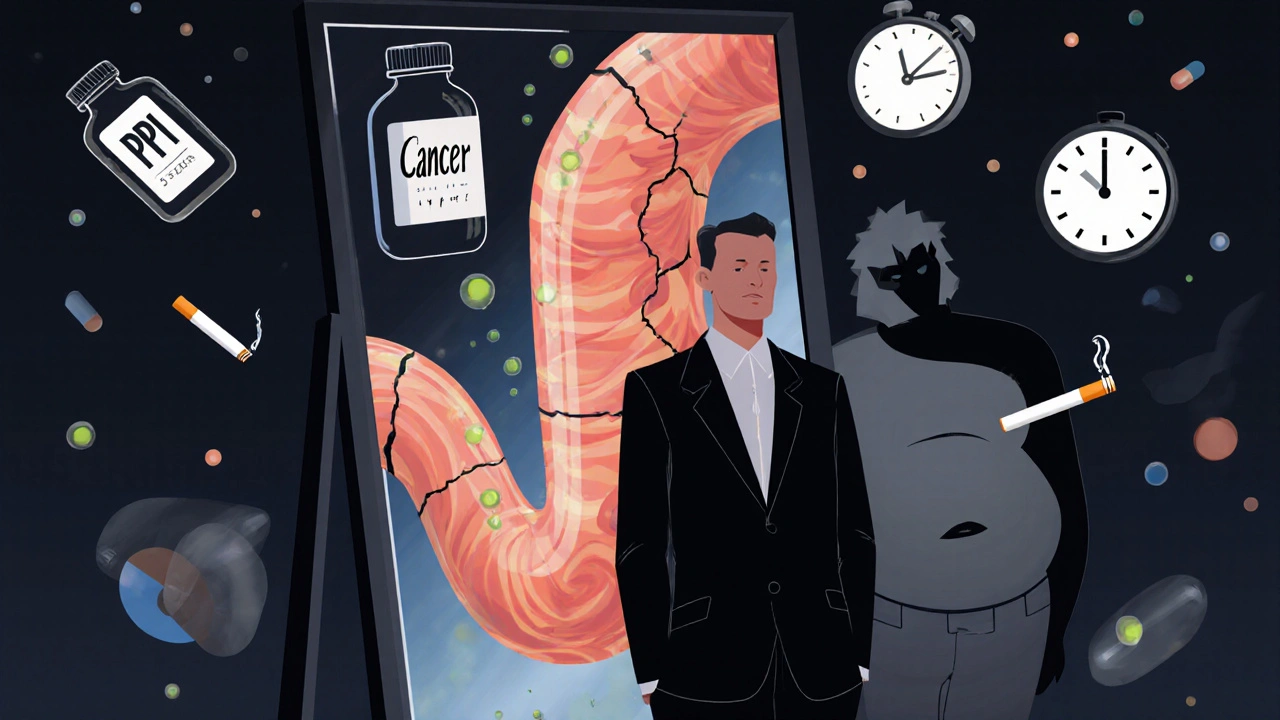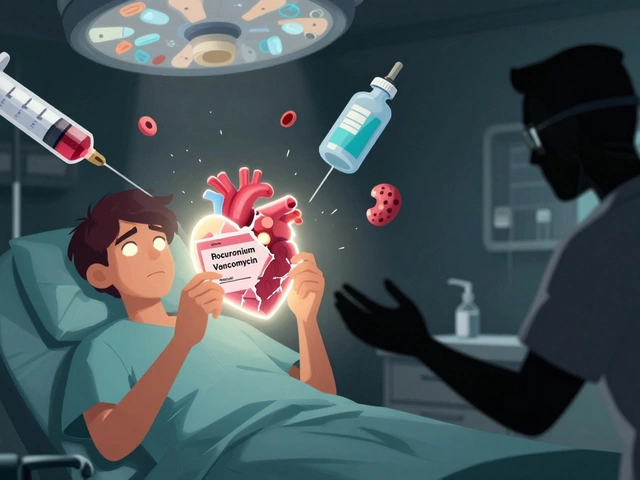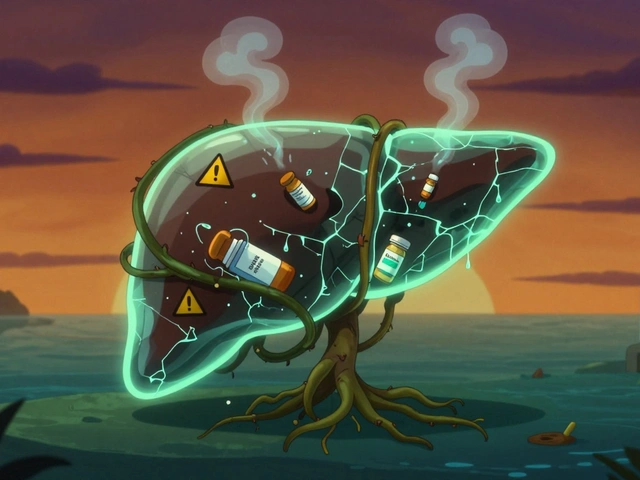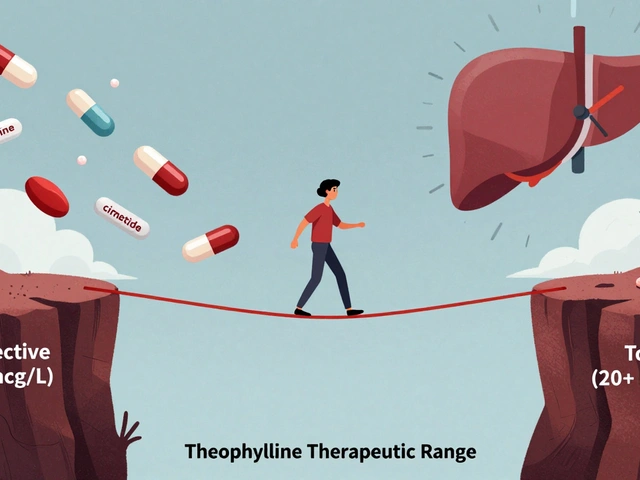
Chronic heartburn isn’t just annoying-it’s a warning sign. If you’ve had acid reflux for more than five years, especially if it happens several times a week, your esophagus might be changing in ways you can’t see. That change is called Barrett’s esophagus, and it’s the body’s attempt to heal itself after years of stomach acid burning the lining. But this healing comes with a hidden cost: it increases your risk of esophageal cancer. The scary part? Most people don’t know they have it until it’s advanced.
What Exactly Is Barrett’s Esophagus?
Barrett’s esophagus happens when the normal pink, flat lining of your esophagus-designed to handle food, not acid-gets replaced by a tougher, salmon-colored tissue that looks more like the lining of your intestine. This is called intestinal metaplasia. It’s not cancer. But it’s a known stepping stone toward it.
This change doesn’t happen overnight. It usually takes at least 10 years of frequent, untreated GERD. The more often you get acid reflux-especially if it’s three or more times a week for over 20 years-the higher your risk. Men are three times more likely to develop it than women. White men over 50, especially those who smoke or carry extra weight around the middle, are at the highest risk.
Here’s the catch: Barrett’s esophagus doesn’t cause new symptoms. If you’re already dealing with heartburn, regurgitation, trouble swallowing, or chest pain, you might assume those are just part of living with GERD. But those same symptoms could be masking a precancerous condition. That’s why you can’t rely on how you feel to know if you’re at risk.
How Is It Diagnosed?
You can’t diagnose Barrett’s esophagus with a blood test or an X-ray. The only way is through an upper endoscopy. During this procedure, a thin, flexible tube with a camera is passed down your throat. The doctor looks for that telltale salmon-colored tissue above the stomach junction. But seeing it isn’t enough.
Biopsies are required. The standard method, called the Seattle protocol, takes 4 tissue samples every 1 to 2 centimeters along the abnormal area. That’s usually 12 to 24 samples total. Why so many? Because cancer doesn’t grow evenly. It shows up in tiny spots. Missing one could mean missing the early warning.
Once the samples are analyzed, the condition is classified:
- Non-dysplastic Barrett’s esophagus (NDBE)-no abnormal cell changes. This is the most common.
- Indefinite for dysplasia-the pathologist isn’t sure if changes are real or just inflammation.
- Low-grade dysplasia (LGD)-early signs of abnormal cells. Still not cancer, but a red flag.
- High-grade dysplasia (HGD)-severe cell changes. This is the last step before cancer. About 6% to 19% of HGD cases turn into cancer each year.
Getting the right diagnosis matters. Studies show that up to 40% of LGD cases are misread by general pathologists. That’s why experts recommend having your biopsies reviewed by a gastrointestinal pathologist who sees these cases regularly.
Who Should Be Screened?
Screening isn’t for everyone. It’s targeted. The American College of Gastroenterology recommends endoscopic screening for men who have:
- Chronic GERD symptoms for more than 5 years
- Symptoms at least once a week
- Plus at least one additional risk factor: age over 50, White race, smoking history, or central obesity (belly fat)
Women and men without these risk factors are generally not screened. Why? Because the overall risk is low, and endoscopy isn’t risk-free. It’s expensive. And if you’re not in a high-risk group, the chance of finding something dangerous is small.
But here’s what many patients don’t realize: if you’ve had GERD for over 10 years and you’re male, you’re already in the danger zone-even if you think your symptoms are mild. A 2022 study found that 68% of people diagnosed with Barrett’s had been ignoring their heartburn for over five years, thinking it was just ‘bad indigestion.’

What Happens After Diagnosis?
If you’re diagnosed with non-dysplastic Barrett’s esophagus, you’re not out of the woods-but you’re not in immediate danger either. Surveillance is key. Most guidelines recommend a repeat endoscopy every 3 to 5 years to watch for changes.
If you have low-grade dysplasia, the approach has changed. In 2022, new guidelines from the American Gastroenterological Association recommended treating LGD with endoscopic therapy, not just watching. Why? Because the AIMS-2 trial showed that 94% of patients had their dysplasia permanently removed after radiofrequency ablation (RFA), with no return over five years.
High-grade dysplasia is treated aggressively. Most patients get RFA or cryotherapy-both use heat or cold to destroy the abnormal tissue. Success rates are high: 90% to 98% of dysplastic tissue can be cleared. Many patients go on to have their normal esophageal lining regrow. One Mayo Clinic patient reported complete eradication of HGD after six months of treatment and has had no recurrence in four years.
But here’s the hard truth: no treatment has been proven to reduce deaths from esophageal cancer. That’s because most people with Barrett’s never develop cancer. We don’t yet know who will. So we screen everyone who might be at risk-even though 95% of them will never get cancer. That’s the burden of prevention.
Lifestyle Changes That Actually Work
Medication alone isn’t enough. Proton pump inhibitors (PPIs) like omeprazole or pantoprazole reduce acid and help symptoms-but they don’t always stop the damage. Studies show that even with daily PPIs, 30% to 45% of patients still have acid reflux at night. That’s why lifestyle changes are non-negotiable.
Here’s what works:
- Stop eating 3 hours before bed
- Elevate the head of your bed by 6 to 8 inches (use blocks, not just pillows)
- Avoid fatty foods, chocolate, caffeine, alcohol, and spicy meals
- Quit smoking
- Get your BMI below 25-losing just 10% of your body weight can cut reflux episodes in half
One study tracked patients who followed these changes strictly. After two years, 60% had reduced their Barrett’s segment length. That’s a sign the tissue is healing.

What’s New in Screening?
Endoscopy is effective-but it’s invasive, expensive, and uncomfortable. That’s why researchers are working on better tools.
The TissueCypher Barrett’s Esophagus Assay, approved by Medicare in 2021, analyzes tissue samples for 14 molecular markers. It’s not a replacement for endoscopy, but it’s a powerful filter. In a study of 635 patients, it had a 96% negative predictive value-meaning if it says you’re low risk, you almost certainly are. That could spare thousands from unnecessary endoscopies.
Another promising area is DNA methylation markers. A $2.4 million study in Texas (2023-2026) is testing whether specific gene changes can predict who’s likely to progress to cancer. If successful, it could reduce surveillance endoscopies by 40%.
The Bottom Line
Barrett’s esophagus is a silent consequence of long-term GERD. It doesn’t hurt more. It doesn’t feel different. But it changes your cancer risk. If you’ve had chronic heartburn for over five years-especially if you’re a man over 50, overweight, or a smoker-talk to your doctor about screening. Don’t wait for symptoms to worsen. Don’t assume it’s ‘just acid reflux.’
Early detection saves lives. Endoscopic ablation can reverse precancerous changes. Lifestyle changes can slow or even stop progression. But only if you know you have it.
Can Barrett’s esophagus go away on its own?
Barrett’s esophagus rarely disappears without treatment. While some patients see a reduction in the length of the abnormal tissue after strict acid suppression and lifestyle changes, the metaplastic cells usually remain. Endoscopic therapies like radiofrequency ablation are the only proven way to remove the abnormal tissue and allow healthy lining to regrow.
If I take PPIs daily, do I still need screening?
Yes. PPIs help control symptoms and reduce acid exposure, but they don’t guarantee full protection. Studies show that even with daily PPI use, many people still experience nighttime acid reflux. Screening is based on your risk profile-not how well your symptoms are controlled.
Is Barrett’s esophagus the same as esophageal cancer?
No. Barrett’s esophagus is a precancerous condition, not cancer. Only about 5% of people with Barrett’s will develop esophageal adenocarcinoma over their lifetime. But because esophageal cancer is aggressive and often caught too late, preventing progression from Barrett’s is critical.
Can women get Barrett’s esophagus?
Yes, but it’s less common. Men are three times more likely to develop it than women. Screening guidelines focus on men because of the higher risk. However, women with long-term GERD and multiple risk factors (obesity, smoking, age over 50) should still discuss screening with their doctor.
How often do I need an endoscopy if I have Barrett’s?
It depends on your dysplasia level. For non-dysplastic Barrett’s, every 3 to 5 years. For low-grade dysplasia, confirm with a specialist, then repeat in 6 to 12 months. High-grade dysplasia usually leads to treatment, not repeat surveillance. Always follow your gastroenterologist’s plan-guidelines vary by center and individual risk.
What happens if I ignore Barrett’s esophagus?
Most people won’t develop cancer-but if you do, it’s often found late. Esophageal adenocarcinoma has a 5-year survival rate of less than 20% when diagnosed after symptoms appear. Early-stage cancer, caught during surveillance, has a much better outlook. Ignoring it means you’re gambling with your life.
Are there alternatives to endoscopy for screening?
Not yet for diagnosis, but new tests are coming. The TissueCypher assay can help determine risk without repeating endoscopy. Capsule endoscopy and swallowable sponge devices are being tested, but none are standard yet. Endoscopy remains the gold standard for detecting Barrett’s and dysplasia.
Can I prevent Barrett’s esophagus?
You can’t prevent it entirely if you have long-term GERD, but you can lower your risk. Lose weight, quit smoking, avoid trigger foods, sleep with your head elevated, and treat reflux aggressively. The earlier you act, the less damage acid will do to your esophagus.






14 Comments
Man I used to think heartburn was just part of being a dad who eats tacos at midnight. Then I started choking on my own spit at 3am and realized my esophagus was basically a rusted pipe. This post hit me like a sledgehammer. I got screened last month and turns out I got Barrett’s. No symptoms got worse. Just… quieter. Like my body was screaming in a language I stopped listening to.
Now I’m on PPIs, no booze, head elevated, and I sleep like a baby. Not because I’m scared of cancer - but because I don’t want to die before I see my kid graduate high school.
/p>So we’re supposed to believe that a tissue change caused by acid exposure is inherently dangerous? That’s like saying your skin gets cancer because you tan too much. Nature adapts. Evolution doesn’t make mistakes. This whole screening industrial complex is just another way to monetize anxiety.
Why not just let the body heal itself? Why the rush to ablate? Who benefits? Pharma? The endoscopy clinics? Not me. I’ll take my salmon-colored lining over a pill mill any day.
/p>YOU’RE NOT SAFE JUST BECAUSE YOU’RE A WOMAN. I’M A 52-YEAR-OLD WOMAN WHO’S HAD HEARTBURN SINCE 2011. I’M OVERWEIGHT. I SMOKE. I DRINK. I’M WHITE. I’M IN THE RISK GROUP. WHY IS EVERYONE ACTING LIKE THIS IS A ‘MALE PROBLEM’? I’M SICK OF BEING ERASED FROM MEDICAL CONVERSATIONS. I GOT SCREENED. I HAVE NDBE. I’M ON TRACK. DON’T TELL ME I DON’T COUNT.
/p>Thank you for this meticulously detailed and clinically accurate exposition. The inclusion of the Seattle protocol and the AIMS-2 trial data is particularly valuable. I am curious, however, regarding the interobserver variability among gastrointestinal pathologists in the interpretation of low-grade dysplasia. Could you elaborate on the specific training protocols that distinguish specialists from general pathologists in this context?
Furthermore, the statistical prevalence of misdiagnosis at 40% is alarming. Might there be a centralized, peer-reviewed repository for biopsy images to improve diagnostic consistency across institutions?
/p>bro i just take tums and chill
why u gotta be so serious
its just acid
we all got it
why u want to cut my throat with a camera
lol
/p>I’ve been on PPIs for 8 years. I feel fine. My doctor says I’m low risk. But I just read this and now I’m crying in the bathroom. I’m 47. I smoke. I eat pizza every Friday. I’ve had heartburn since college. I thought I was just ‘bad at life.’ Now I think I’m a ticking time bomb. Why didn’t anyone tell me this before I was 40?
/p>you guys are missing the point. barrett’s isn’t cancer. it’s a scar. scars don’t kill you. ignoring your health does. if you’re not changing your lifestyle, you’re not fixing anything. ppi’s are bandaids. losing weight? sleeping right? not eating at midnight? that’s the real cure. stop looking for magic bullets. stop letting doctors scare you into procedures. fix your damn life first.
/p>I appreciate how balanced this is. I have a friend who was diagnosed with LGD and she panicked for months. Then she found a specialist who said, ‘Let’s wait, monitor, and focus on your diet.’ She lost 30 pounds, stopped drinking coffee, and her follow-up biopsy showed no dysplasia. It’s not about fear. It’s about awareness. And patience.
Also - elevating the bed with blocks? Genius. I tried pillows. They just made my neck hurt.
/p>AMERICA IS GETTING WEAK. WE USED TO JUST GRIND OUR TEETH AND EAT SPICY FOOD. NOW WE’RE GETTING CAMERAS DOWN OUR THROATS BECAUSE WE CAN’T HANDLE A LITTLE HEARTBURN? I’M A VET. I’VE SEEN BLOOD. I’VE SEEN BONES. THIS? THIS IS A THERAPY CULTURE PROBLEM. STOP TREATING YOUR BODY LIKE A FANCY CAR THAT NEEDS SERVICE EVERY 5 YEARS.
YOU WANT TO LIVE LONGER? STOP BEING A COWARD. EAT THE TACO. SMOKES THE CIG. AND DON’T COME CRYING TO ME WHEN YOUR ESOPHAGUS GETS WEIRD.
/p>How quaint. You Americans treat your digestive system like a delicate porcelain doll. In India, we’ve been drinking spicy chaat, eating fried snacks at midnight, and drinking hot chai with meals since birth. No one gets Barrett’s. No one gets cancer. Because we don’t fear our bodies - we respect them by living fully, not by scheduling endoscopies like yoga classes.
This is what happens when you outsource your biology to corporations. You pay for anxiety. You pay for scans. You pay for ablation. Meanwhile, in Delhi, people live to 90 with GERD and no PPIs. The truth? You’re not sick. You’re just spoiled.
/p>Just wanted to say - this thread has been really helpful. I’m 58, male, overweight, had GERD since 40. I’ve been avoiding the endoscopy because I’m scared. But reading all this - especially the part about how 68% of people ignored symptoms for years - made me realize I’m not alone. I’m scheduling mine next week. Thanks for being real.
/p>I’m not here to argue. I just needed to say - I have Barrett’s. NDBE. I follow all the lifestyle stuff. I take my meds. I sleep elevated. I don’t drink. I lost 25 lbs. I still get scared sometimes. But I’m not ashamed. I’m just trying to live. Thanks for the info. It helps.
/p>As someone who practices Ayurveda and has studied gastroenterology in both India and the US - I see a beautiful convergence here. The body’s intelligence is undeniable. Barrett’s is not a disease - it is a signal. The modern medical approach seeks to remove the signal. But the ancient wisdom teaches us to listen to it.
Reduce pitta. Avoid night meals. Practice breathwork. Use amla and licorice root. These are not alternatives - they are foundations. Combine them with modern science - and you get true healing.
Do not fear the camera. Fear the silence of your body.
/p>As a first-generation immigrant from the Philippines, I’ve seen how Western medicine treats chronic conditions like this - with precision, but also with fear. In my culture, we say: ‘The body speaks, but only if you’re quiet enough to hear.’ This post is a wake-up call - not just medically, but culturally. We need to stop outsourcing our health to algorithms and endoscopes. We need to reclaim our relationship with our bodies.
Screening is good. But so is silence. So is stillness. So is knowing when to act - and when to breathe.
/p>